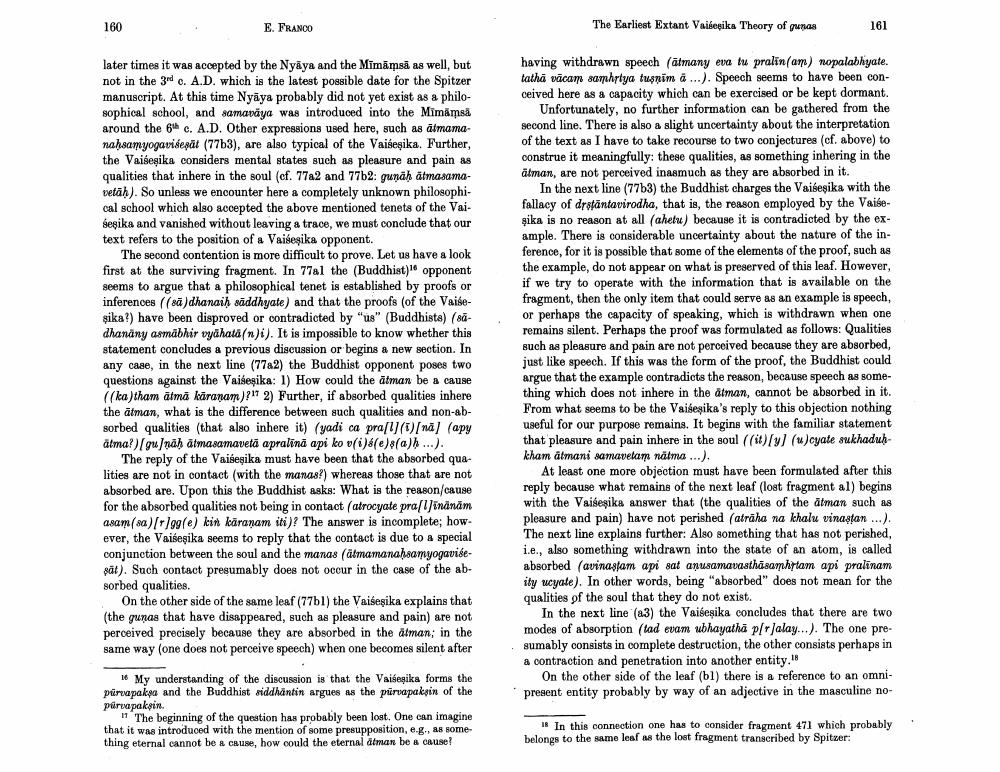Book Title: Earliest Extant Vaisesika Theory Of Gunas Author(s): Eli Franco Publisher: Eli Franco View full book textPage 4
________________ 160 E. FRANCO later times it was accepted by the Nyaya and the Mimamsa as well, but not in the 3rd c. A.D. which is the latest possible date for the Spitzer manuscript. At this time Nyaya probably did not yet exist as a philosophical school, and samaväya was introduced into the Mimämsä around the 6th c. A.D. Other expressions used here, such as atmamanaḥsamyogaviseṣāt (77b3), are also typical of the Vaiseṣika. Further, the Vaiseşika considers mental states such as pleasure and pain as qualities that inhere in the soul (cf. 77a2 and 77b2: gunaḥ atmasamavetāḥ). So unless we encounter here a completely unknown philosophical school which also accepted the above mentioned tenets of the VaiSeşika and vanished without leaving a trace, we must conclude that our text refers to the position of a Vaisesika opponent. The second contention is more difficult to prove. Let us have a look first at the surviving fragment. In 77al the (Buddhist)16 opponent seems to argue that a philosophical tenet is established by proofs or inferences ((sa) dhanaiḥ saddhyate) and that the proofs (of the Vaiseşika?) have been disproved or contradicted by "us" (Buddhists) (sãdhanany asmabhir vyähatä(n)i). It is impossible to know whether this statement concludes a previous discussion or begins a new section. In any case, in the next line (77a2) the Buddhist opponent poses two questions against the Vaisesika: 1) How could the atman be a cause ((ka)tham ātmā kāranam)? 2) Further, if absorbed qualities inhere the atman, what is the difference between such qualities and non-absorbed qualities (that also inhere it) (yadi ca pra[l](i)[na] (apy atma?)[gu]nāḥ atmasamaveta apralīnā api ko v(i)s(e)s(a)h...). The reply of the Vaiseşika must have been that the absorbed qualities are not in contact (with the manas?) whereas those that are not absorbed are. Upon this the Buddhist asks: What is the reason/cause for the absorbed qualities not being in contact (atrocyate pra[1]inānām asam (sa)[r]gg(e) kin käraṇam iti)? The answer is incomplete; however, the Vaiseșika seems to reply that the contact is due to a special conjunction between the soul and the manas (ätmamanaḥsamyogavisesat). Such contact presumably does not occur in the case of the absorbed qualities. On the other side of the same leaf (77b1) the Vaisesika explains that (the gunas that have disappeared, such as pleasure and pain) are not perceived precisely because they are absorbed in the atman; in the same way (one does not perceive speech) when one becomes silent after 16 My understanding of the discussion is that the Vaisesika forms the purvapaksa and the Buddhist siddhantin argues as the purvapaksin of the purvapaksin. The beginning of the question has probably been lost. One can imagine that it was introduced with the mention of some presupposition, e.g., as something eternal cannot be a cause, how could the eternal ätman be a cause? The Earliest Extant Vaisesika Theory of gunas having withdrawn speech (atmany eva tu pralin(am) nopalabhyate. tathā vācam samhrtya tusnim a...). Speech seems to have been conceived here as a capacity which can be exercised or be kept dormant. Unfortunately, no further information can be gathered from the second line. There is also a slight uncertainty about the interpretation of the text as I have to take recourse to two conjectures (cf. above) to construe it meaningfully: these qualities, as something inhering in the atman, are not perceived inasmuch as they are absorbed in it. 161 In the next line (7763) the Buddhist charges the Vaiseşika with the fallacy of drstäntavirodha, that is, the reason employed by the Vaiseşika is no reason at all (ahetu) because it is contradicted by the example. There is considerable uncertainty about the nature of the inference, for it is possible that some of the elements of the proof, such as the example, do not appear on what is preserved of this leaf. However, if we try to operate with the information that is available on the fragment, then the only item that could serve as an example is speech, or perhaps the capacity of speaking, which is withdrawn when one remains silent. Perhaps the proof was formulated as follows: Qualities such as pleasure and pain are not perceived because they are absorbed, just like speech. If this was the form of the proof, the Buddhist could argue that the example contradicts the reason, because speech as something which does not inhere in the atman, cannot be absorbed in it. From what seems to be the Vaišeşika's reply to this objection nothing useful for our purpose remains. It begins with the familiar statement that pleasure and pain inhere in the soul ((it) [y] (u)cyate sukhaduḥkham atmani samavetam nätma...). At least one more objection must have been formulated after this reply because what remains of the next leaf (lost fragment al) begins with the Vaisesika answer that (the qualities of the atman such as pleasure and pain) have not perished (atraha na khalu vinaṣṭan ...). The next line explains further: Also something that has not perished, i.e., also something withdrawn into the state of an atom, is called absorbed (avinastam api sat anusamavasthāsamhṛtam api pralinam ity ucyate). In other words, being "absorbed" does not mean for the qualities of the soul that they do not exist. In the next line (a3) the Vaiseşika concludes that there are two modes of absorption (tad evam ubhayatha p[r]alay...). The one presumably consists in complete destruction, the other consists perhaps in a contraction and penetration into another entity.18 On the other side of the leaf (bl) there is a reference to an omnipresent entity probably by way of an adjective in the masculine no 18 In this connection one has to consider fragment 471 which probably belongs to the same leaf as the lost fragment transcribed by Spitzer:Page Navigation
1 2 3 4 5
